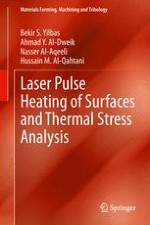2014 | Buch
Laser Pulse Heating of Surfaces and Thermal Stress Analysis
verfasst von: Bekir S. Yilbas, Ahmad Y. Al-Dweik, Nasser Al-Aqeeli, Hussain M. Al-Qahtani
Verlag: Springer International Publishing
Buchreihe : Materials Forming, Machining and Tribology
